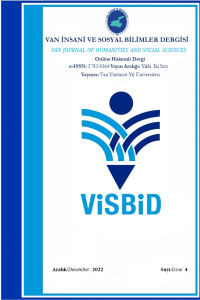Elaiussa Sebaste Antik Kentinden Konka Bülloza (Concha Bullosa) Örneği ve Paleoantropolojide Mobil Dijital Görüntüleme Teknikleri
Abstract
Burun içinde yer alan ve görevleri arasında hava akımının sağlanmasını ve filitrasyon işlemi yapılmasını sağlayan nazal konkalar alt, orta ve üst olarak isimlendirilirler. Konka bülloza, konkaların bir kemik duvardan oluşması yerine bir hava boşluğu oluşturması ile meydana gelen bir varyasyondur. Modern toplumlarda yaygın görülen bu varyasyon eski toplumlarda daha nadir rapor edilmiştir. Konka bülloza bir varyasyon olarak değerlendirilmesinin yanı sıra sinüzit, baş ağrısı, koku kaybı gibi durumlara neden olduğu düşünülmektedir. Bu bağlamda patolojik bir durum olmamasına rağmen sağlık sorunlarına yol açma potansiyeli nedeniyle paleopatolojik çalışmalarda da yer almaktadır. Bu çalışmada Elaiussa Sebaste Antik Kentinden Bizans Dönemine ait konka bülloza örneği çalışmamızın materyalini oluşturmaktadır. Çalışmamızda iskelet örneğinin yaş ve cinsiyet belirlemelerinin yanı sıra paleopatololojik değerlendirme de yapılmıştır. Bireyin 25-35 yaş aralığında bir erkek birey olduğu ve konka bülloza dışında buttom osteoma, cribra orbitalia, porotic hyperostosis gibi patolojik durumlara sahip olduğu tespit edilmiştir. Bireyde tek taraflı konka bülloza tespit edilmiştir. Konka bülloza nedeniyle nazal septumda sapma izlenmiş ayrıca maxiller sinüs bölgesine yakın alanda enfeksiyon benzeri izler tespit edilmiştir. Bu çalışmada konka bülloza örneğinin fotoğraflanması dışında hem röntgen görüntülemesi hem de mobil dijital 3D görüntülemesi yapılarak belgelenmesi yapılmıştır. Sonuç olarak modern toplumlarda yaygın görünmesine rağmen eski toplumlarda daha az örnekle temsil edilen konka büllozanın nadir görülmesinin temel sebepleri arasında narin, hassas ve kırılgan olan burun bölgesinin tafonomik nedenlerle hasar görmesi ve bu sebeplerle kayıt altına alınamaması ya da gözden kaçan bir konu olduğu literatür değerlendirmemizde irdelenmiştir. Bizim örneğimiz de eski Anadolu toplumlarına ilişkin çalışmalarda şimdiye kadar görülen tek örneği temsil etmektedir. Bu nadir rapor edilen örneğin sadece fotoğraflama ile değil mobil dijital üç boyutlu (3D) görüntüleme ile kayıt altına alınıp veri arşivimizde yer almasın ve yakın gelecekte eğitim materyali olarak kullanımını sağlamaya çalıştık. Bu bağlamda Hassas materyallerin dijitalleştirilmesinin, dijital arşiv oluşturulmasının ve yaygınlaşmasının bu anlamda öneminin olduğunu düşünülmektedir.
References
- Akagün, F., Atalay Erdoğan B., Bora F. (2013). Bilateral Alt Konka Pnömatizasyonu: Bakırköy Tıp Dergisi 2013;9:36-38. Acsa´di, G., Nemeske´ri J. (1970). History of Human Life Span and Mortality. Akademia Kiado: Budapest Aşantoğrol, F., Canger E.M., Coşgunarslan A., Kış H.C. (2019). Selcuk Dent J, ODMFR 2019 Kongre Kitapçığı Özel Sayısı Aytek., A.İ., (2013). “Üç Boyutlu Tarih”, Bilim ve Teknik. sf 70-72 Bakır, S. (2009). Dev konka bülloza piyoseli olgusu Dicle Tıp Derg/Dicle Med J Cilt/Vol 36, No 4, 306-309
Concha bullosa Sample from the Ancient City of Elaiussa Sebaste and Mobile Digital Imaging Techniques at Paleoanthropology
Abstract
The nasal concha, which are located in the nose and perform intranasal airflow and filtration, are named as lower, middle and upper. Concha bullosa is a variation in which the concha form an air space rather than a bony wall. This variation, which is common in modern societies, has been reported less frequently in ancient societies. In addition to being evaluated as a variation of concha bullosa, it is thought to cause conditions such as sinusitis, headache, and loss of smell. In this context, although it is not a pathological condition, it is also included in paleopathological studies due to its potential to cause health problems. In this study, the sample of concha bullosa from the Ancient City of Elaiussa Sebaste from the Byzantine Period constitutes the material of our study. In our study, in addition to age and sex determination of the skeletal specimen, paleopathological evaluation was also performed. It has been determined that the individual is a male individual between the ages of 25-25 and has pathological conditions such as buttom osteoma, cribra orbitalia, porotic hyperostosis other than concha bullosa. Unilateral concha bullosa was detected in the individual. Nasal septum deviation was observed due to concha bullosa, and infection-like scars were detected in the area close to the maxillary sinus area. In this study, besides photographing the concha bullosa sample, it was documented by both x-ray imaging and mobile digital 3D imaging. As a result, it has been examined in our literature review that although it is common in modern societies, the main reasons for the rarity of concha bullosa, which is represented with fewer examples in ancient societies, are that the delicate, sensitive and fragile nasal region is damaged due to taphonomic reasons and cannot be recorded for these reasons or is an overlooked issue. Our example also represents the only example seen so far in studies on ancient Anatolian societies. We tried to ensure that this rarely reported example is recorded not only with photography but also with mobile digital three-dimensional (3D) imaging, included in our data archive, and used as educational material in the near future. In this context, it is thought that the digitization of sensitive materials, the creation and dissemination of digital archives are important in this sense.
References
- Akagün, F., Atalay Erdoğan B., Bora F. (2013). Bilateral Alt Konka Pnömatizasyonu: Bakırköy Tıp Dergisi 2013;9:36-38. Acsa´di, G., Nemeske´ri J. (1970). History of Human Life Span and Mortality. Akademia Kiado: Budapest Aşantoğrol, F., Canger E.M., Coşgunarslan A., Kış H.C. (2019). Selcuk Dent J, ODMFR 2019 Kongre Kitapçığı Özel Sayısı Aytek., A.İ., (2013). “Üç Boyutlu Tarih”, Bilim ve Teknik. sf 70-72 Bakır, S. (2009). Dev konka bülloza piyoseli olgusu Dicle Tıp Derg/Dicle Med J Cilt/Vol 36, No 4, 306-309
Details
| Primary Language | Turkish |
|---|---|
| Journal Section | Research Articles |
| Authors | |
| Publication Date | December 29, 2022 |
| Submission Date | November 22, 2022 |
| Published in Issue | Year 2022 Issue: 4 |
ViSBiD, MLA ve Crossref tarafından indekslenmektedir. Ayrıca Index Copernicus takip sistemine alınmıştır.


